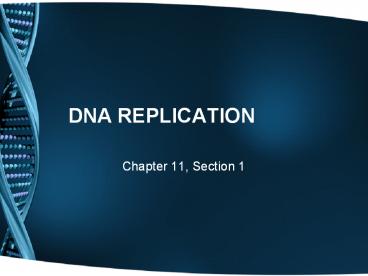DNA REPLICATION - PowerPoint PPT Presentation
1 / 10
Title:
DNA REPLICATION
Description:
Chapter 11, Section 1 DNA Review What is the building block of DNA? Nucleotides What is the shape of DNA? Double Helix What holds together the two strands of DNA? – PowerPoint PPT presentation
Number of Views:102
Avg rating:3.0/5.0
Title: DNA REPLICATION
1
DNA REPLICATION
- Chapter 11, Section 1
2
DNA Review
- What is the building block of DNA?
- Nucleotides
- What is the shape of DNA?
- Double Helix
- What holds together the two strands of DNA?
- Hydrogen bonds between complimentary nitrogen
base pairs - During what part of the Cell Cycle does DNA
replicate (copy itself)? - Interphase (S phase)
- What pairs with Guanine? Adenine?
- Guanine Cytosine, Adenine Thymine
- What are the complimentary bases for the
following sequence? AATCCGC - TTAGGCG
3
(No Transcript)
4
How DNA Replicates
- DNA has to be replicated before a cell divides
(during S phase of interphase). - New cells at the end of Mitosis need identical
strands of DNA
5
- One strand of DNA gets used as a template
(pattern) to make a new strand that matches up
with it. - This is called semi-conservative replication, one
strand is new and the other is old. - Special enzymes are required for DNA replication
6
Steps of DNA Replication
- 1. Replication begins with the unwinding
separation of the DNA double helix by enzymes
called helicases - The process is like unzipping a zipper
7
- 2. New strands are formed by enzymes called DNA
polymerase which adds complimentary nucleotides
to the original strands
8
- Each new strand compliments one of the original
strands (one new strand and one old strand
semi-conservative replication) - 2 identical DNA double helix strands are the
result of DNA replication
9
Uneven formation of DNA
- When DNA is replicating one strand forms
continuously and the other strand forms in chunks
(Okazaki fragments) with spaces that need to be
filled in. - Because they form in opposite directions
- Continuously leading strand Chunks lagging
strand
10
- http//www.mcb.harvard.edu/losick/images/trombonef
inald.swf - http//www.stolaf.edu/people/giannini/flashanimat/
molgenetics/dna-rna2.swf - http//www.wiley.com/college/pratt/0471393878/stud
ent/animations/dna_replication/index.html































